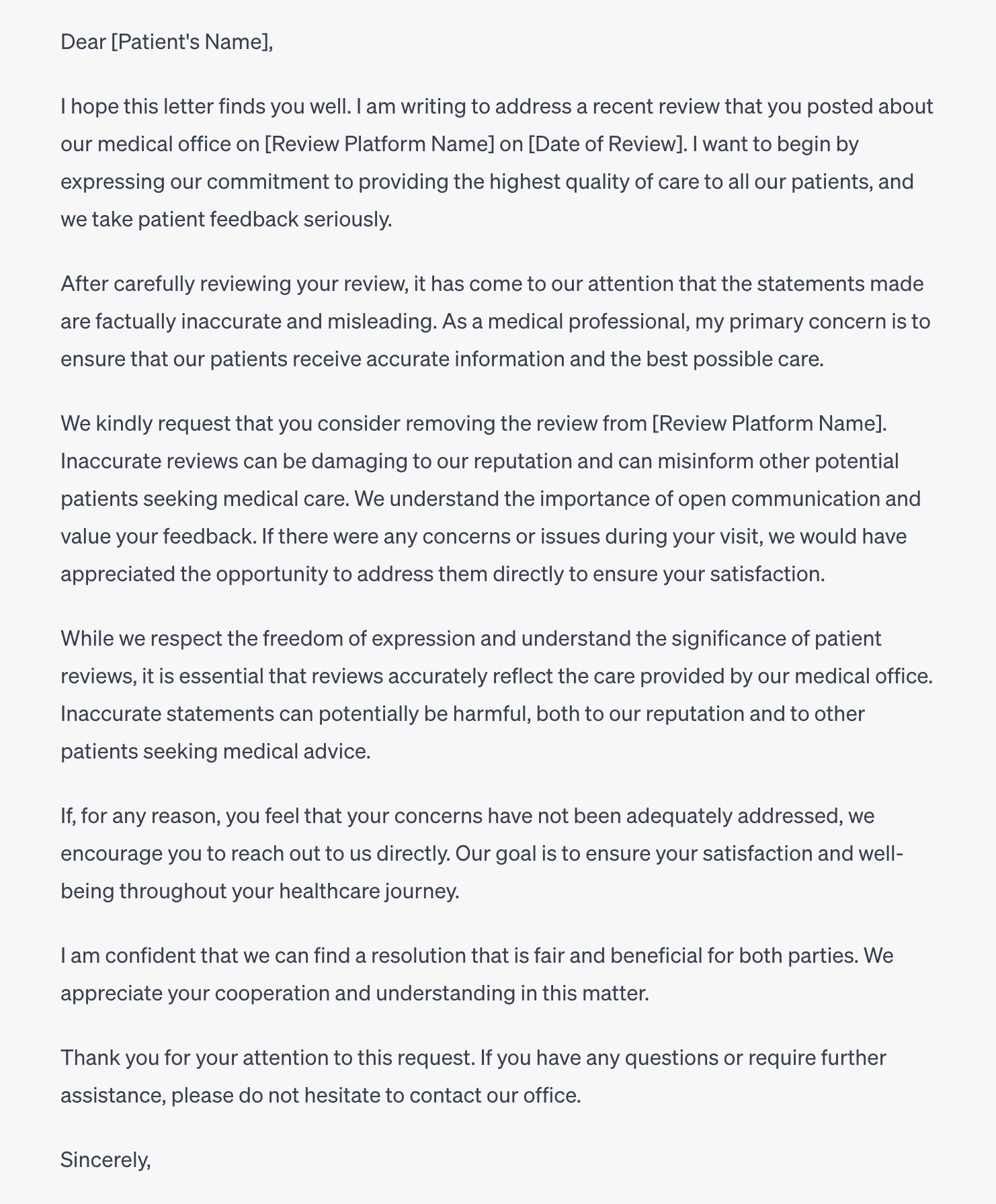You can remove a bad review by simply asking for it! You can remove a negative review by threatening your patient with legal action! You can remove a bad review by deleting your account. You can remove a bad review by challenging the source with the third-party website. You can remove negative feedback and bad rating by other legal means.
But the question is… should you?
To answer that question let’s find a reponse to these:
- What should I do when I get a bad review?
- When should I respond to a negative review?
- How should I prevent getting bad reviews?
The First Step
The most important thing to do right after getting a bad review is:
NOTHING!
First, you must manage your emotions and calm down from the potentially upsetting effect of the content in the review and the unfairness of it all. Only after you are calm and the time of the day is right start managing the situation by learning more.
Gathering Information
The second step is to gather information. Try your best to be as objective as possible. Ask staff not to add comments to the story and only tell you the facts of the matter. If you were involved yourself, try to separate emotions and commentary from the facts.
Determine Reasons
There are three possibilities at the root of bad reviews. Try your best to pick the right answer.
- The patient is right. The practice made a mistake. Even if the review is unfair, acknowledge internally that the main reason for the negative feedback was a mistake.
- There has been a misunderstanding. Maybe there was a miscommunication.
- It is the patient that is the problem! Some offices just say things like: “This patient is crazy,” “he has issues,” “he was this way from the start,” “he is dishonest,” “he does not want to pay,”…
Planning Phase
After gathering all the information and determining the reasons, make a decision about how you would like to address this. The first option should always be resolving the issue and making the patient happy if possible.
Either way, it is important to consider different scenarios so that when you contact the patient, you don’t make an impulsive decision. You don’t want to get emotional and make things worst. Go over all the possibilities and decide how you would manage each.
Is getting good reviews really worth it?
Contacting the Patient
Making the first call is always best for the highest rank in the practice. Your goal should be resolving the issue and addressing the problem, so your patient is not upset anymore. These are some tips to follow:
- Wait for Emotions to Settle: Give yourself and the patient some time to cool off after the negative review. Responding immediately may not yield the best results if emotions remain high.
- Verify the Facts: Before contacting the patient, gather all the necessary information about the situation. Understand the context of their experience and verify the accuracy of the details.
- Contact Privately: Reach out to the patient privately, either through email or phone, rather than responding publicly to the review. This shows that you take their concerns seriously and respect their privacy.
- Show Empathy and Understanding: Start the conversation with empathy, acknowledging the patient’s feelings and concerns. Let them know that their feedback is essential to you.
- Apologize Sincerely: Offer a genuine and heartfelt apology for the negative experience they had. Even if you believe there was a misunderstanding, focus on the patient’s perception and emotions.
- Avoid Being Defensive: Resist the urge to be defensive or argumentative. Instead, listen to the patient’s perspective without interruption and try to see things from their point of view.
- Ask Open-ended Questions: Encourage the patient to share more details about their experience. Asking open-ended questions can help you gain a deeper understanding of their concerns.
- Be Transparent: Be transparent in your communication and, if necessary, share the steps you are taking to investigate and address the issues raised in the review.
- Propose a Resolution: Offer a suitable resolution based on the patient’s concerns. This may include scheduling a follow-up appointment, refunding, or providing additional support.
- Follow Through: If you promise to take specific actions or make changes, ensure that you follow through with them promptly. Keep the patient informed about the progress.
- Keep it Confidential: Respect the patient’s privacy and keep all interactions confidential. Avoid discussing the specifics of the situation with anyone else unless necessary.
- Thank Them for Feedback: Express gratitude for the patient’s willingness to share their feedback. Emphasize that their input will help improve the practice’s quality of care.
Post-Contact Steps
There are three possibilities after your initial conversation. Either the issue is resolved, or it is delayed, or worst escalated.
1. Issue is resolved
If you find a solution and the patient is now OK, most likely, they will remove the review, and you can move to the ‘prevention’ phase.
2. Disagreement remains
There is a possibility that the two of you agree to disagree. The patient is still unhappy with the solutions you offered, and you are unwilling or able to offer any further resolution. Before taking the next step, wait for a few days, and try again to resolve the disagreement after the patient has time to calm down.
If still no luck. Start by responding to the review. Here is a detailed guide to responding to bad reviews.
3. The problem is escalated
What if things get out of hand or even worse during that conversation? What if the patient is just not fair, reasonable, or worst dishonest and has ‘real’ issues?
In those situations, you can do two things:
- Respond to the review by following our guide and continue your practice.
- Fight the bad review
Fighting and Removing a Bad Review
You can fight a bad review by two different methods. Challenging the review with the review website. Or legally going after the patient.
How to ask for the removal of a review
While this is not easy, there are policies that sites like Yelp and Google follow that allow you to challenge the review. For example, Yelp allows doctors to request the removal of a bad review based on the following policies (the most common situation is in bold):
- Content Guidelines: Reviews that violate Yelp’s content guidelines can be flagged and possibly removed.
- Reviews containing hate speech, offensive language, or sexually explicit content.
- Reviews that incite violence or promote illegal activities.
- Reviews that disclose personal or confidential information about individuals.
- Conflict of Interest: Reviews from individuals with a clear conflict of interest, such as competitors or current/ former employees, may be subject to removal.
- Reviews are written by competitors attempting to undermine the doctor’s reputation.
- Reviews from current or former employees with biases against the doctor.
- Inappropriate Content: Reviews containing inappropriate language, personal attacks, or discriminatory remarks may be removed.
- Reviews with personal attacks or derogatory remarks directed at the doctor or other reviewers.
- Reviews containing discriminatory language based on race, gender, religion, or other characteristics.
- Fake Reviews: Yelp takes action against fake or fraudulent reviews that misrepresent the patient’s experience.
- Reviews from fake or fictitious accounts are created solely to promote or criticize the doctor.
- Reviews are written by friends or family members of the doctor to boost ratings artificially.
- Irrelevant Content: Reviews unrelated to the doctor’s services or patient experience may be eligible for removal.
- Reviews that do not pertain to the doctor’s services or patient experience but focus on unrelated topics.
- Reviews that do not pertain to the doctor’s services or patient experience but focus on unrelated topics.
- Promotional or Spam Content: Reviews with promotional or spam-like characteristics may be flagged and removed.
- Reviews that include promotional links, advertisements, or unrelated content to the doctor’s services.
- The same user posts multiple identical or nearly identical reviews.
- Prohibited Content: Reviews that contain prohibited content, such as illegal content or content violating intellectual property rights, may be removed.
- Reviews containing illegal content, such as threats or solicitations for illegal activities.
- Reviews infringe on copyrights, trademarks, or other intellectual property rights.
It’s important to note that Yelp’s review removal process is subject to their discretion, and doctors should follow Yelp’s specific guidelines and procedures to request the removal of a review. Remember that policies and guidelines may change over time. But as you can see, many of these policies apply to bad reviews written by emotional patients.
Taking legal action
The best chance of winning a legal fight over a review is if your patient has lied in her/his review. While the first amendment protects sharing opinions, lying about a business and hurting it by using inaccurate or misleading information can be considered defamation.
If that is the case, you can initially and politely inform the patient that you are planning to take that next step since the information is not right, and you can claim defamation. You can ask your attorney to write a letter. How you do it is very important, so don’t make things worst by coming across as bullying.
Below is an example of such a letter that has worked for many businesses. Please note this is just an example letter for demonstration purposes. Do not use this letter for your specific situation. Contact your attorney.

This works often. Especially because most unfair patients exaggerate and change the facts to make themselves more of a victim, which is good for you. Some attorneys may do this for a small fee.
If this does not work, you can make a decision about the next step, but one bad review is rarely worth fighting over going through actual legal proceedings.
Preventing negative reviews in the future
No matter what solution you choose and how you end up, this is a necessary step. Below are the most important practices you can implement in your office to avoid future negative reviews:
Preventing bad reviews in your medical office requires a proactive approach to patient care and communication. Here are some strategies to help you minimize the likelihood of receiving negative reviews:
- Excellent Patient Care: Prioritize patient care and satisfaction. Ensure that all staff members, including medical professionals and administrative staff, are trained to deliver exceptional service and empathy to patients.
- Clear Communication: Maintain open and transparent communication with patients. Explain treatment options, procedures, and potential outcomes clearly, addressing any questions or concerns they may have.
- Manage Expectations: Set realistic expectations for treatment outcomes, recovery times, and potential risks. Avoid overpromising or making guarantees that cannot be fulfilled.
- Minimize Waiting Times: Respect your patients’ time by minimizing waiting times. Efficient scheduling and time management can help reduce patient frustration.
- Quality Care Consistency: Ensure consistency in the quality of care across all patient interactions. Every patient should receive the same level of attention and personalized care.
- Act on Feedback: Encourage patient feedback and act on it promptly. Address any patient issues or concerns and take steps to improve your services accordingly.
- Follow-Up: After procedures or appointments, follow up with patients to inquire about their experiences and address any post-treatment questions or concerns.
- Stay Updated: Stay up-to-date with the latest medical advancements and best practices to provide your patients with the highest level of care.
- Staff Training: Train your staff in customer service, effective communication, and conflict resolution to handle challenging situations professionally and empathetically.
- Online Reputation Management: Monitor your online presence and respond promptly and professionally to any online reviews or feedback, whether positive or negative.
- Educational Resources: Provide educational resources to your patients, such as brochures, website content, or video explanations, to help them make informed decisions about their healthcare.
- Patient Privacy: Ensure strict adherence to patient privacy and data protection regulations, such as HIPAA (in the United States). Patients must feel that their information is secure with your practice.
- Cultivate Positive Patient Relationships: Building strong, positive relationships with patients can lead to increased patient loyalty and satisfaction.
- Focus on Prevention: Prioritize preventive care and patient education to minimize the occurrence of medical issues and ensure patients are actively involved in their health management.
By implementing these strategies, you can create a patient-centered medical office prioritizing exceptional care, clear communication, and continuous improvement. A positive patient experience is crucial for minimizing bad reviews and building a strong reputation for your medical or dental practice.












